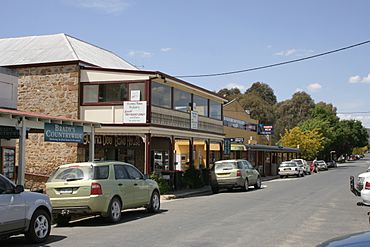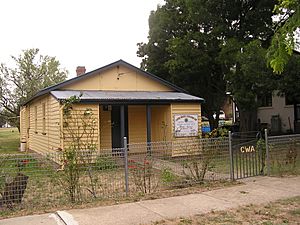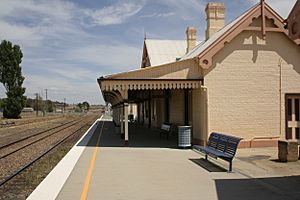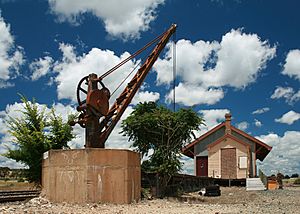Bungendore facts for kids
Quick facts for kids BungendoreNew South Wales |
|||||||||||||||
|---|---|---|---|---|---|---|---|---|---|---|---|---|---|---|---|

Gibraltar Street
|
|||||||||||||||
| Population | 4,745 (2021 census) | ||||||||||||||
| Established | 1837 | ||||||||||||||
| Postcode(s) | 2621 | ||||||||||||||
| Elevation | 700 m (2,297 ft) | ||||||||||||||
| Location |
|
||||||||||||||
| LGA(s) | Queanbeyan-Palerang Regional Council | ||||||||||||||
| County | Murray | ||||||||||||||
| Parish |
|
||||||||||||||
| State electorate(s) | Monaro | ||||||||||||||
| Federal Division(s) | Eden-Monaro | ||||||||||||||
|
|||||||||||||||
|
|||||||||||||||
Bungendore is a town in the Queanbeyan Region of New South Wales, Australia. It is part of the Queanbeyan-Palerang Regional Council. The town is located on the Kings Highway, close to Lake George, the Molonglo River Valley, and the border of the Australian Capital Territory.
Bungendore has become a popular place for tourists, especially those visiting from nearby Canberra. Many of its historic buildings are protected. In recent years, the town has grown quickly as many people who work in Canberra have chosen to live in Bungendore.
Contents
Bungendore's Past: A Look at History

Before Europeans arrived, the Ngarigo people lived in this area. Their lands stretched to the southern shore of Lake George.
The first Europeans to explore this region were Dr Charles Throsby and Hamilton Hume in 1820. Later, in 1824, botanist Allan Cunningham also passed through Bungendore. The first European settlers arrived a year later.
In 1837, a mail service started in Bungendore. This made the village more important, and it was officially declared a "town" in the same year. Also in 1837, a surveyor named James Larmer planned the town's streets in a grid pattern, similar to Georgian-style towns.
By 1848, about 30 people lived in Bungendore, which had seven buildings. The town began to grow much faster when the railway arrived on March 4, 1885. Soon, new buildings like churches, a courthouse, police station, two schools, and a post office were built.
The first post office was built in 1840. An Anglican church was built around 1843, and the Bungendore Inn opened in 1847. This inn became a stop for the Pooley and Malone coach service. By 1851, the population had grown to 63 people. In the 1850s, at least two more hotels were built.
A flour mill was built in 1861. St Mary's Roman Catholic Church and two church schools opened in 1862. The courthouse was built in 1864, and a public school in 1868. In 1866, farmers in the area grew crops like wheat, oats, barley, and potatoes. Today, tourism is a big part of the town's economy.
Bungendore was a main railway stop from 1885 until the train line reached Queanbeyan in 1887. The 1880s were a busy time for the town, partly because of the railway. The population grew from 270 in 1881 to 700 by 1885. However, Queanbeyan soon became the larger town nearby. Bungendore was again declared a village in 1885.
In 1894, gold was found at Bywong, a nearby area. In 1901, a spot near Lake George, just north of Bungendore, was suggested as a possible location for Australia's capital city. But this idea didn't happen.
By 1909, catching rabbits became a very important business around Bungendore. The town even had a rabbit-freezing plant that employed 14 workers and over 250 trappers. In one year, more than 1.5 million rabbits were frozen in Bungendore!
In 2017, Bungendore set a fun record! At an event called the Werriwa Wiener Dash, held during the annual Bungendore Show, 154 dachshund dogs gathered. This was the most dachshunds in one place outside of a dog show.
Historic Places in Bungendore
Bungendore has several places that are listed for their historical importance:
- Gibraltar Street: Bungendore railway station
- St Philip's Anglican Church
Who Lives in Bungendore?
In 2021, there were 4,745 people living in Bungendore.
- Most people (83.5%) were born in Australia.
- The next largest group (4.8%) was born in England.
- About 2.5% of people identified as Aboriginal and/or Torres Strait Islander.
- Most people (92.7%) spoke only English at home.
- The average age in Bungendore is 38 years, which is the same as the rest of Australia.
- The average household income was $2,922 per week, which is higher than the national average.
- For religion, the most common answers were: No Religion (44.7%), Catholic (23.0%), and Anglican (15.9%).
Bungendore's Location and Weather
Bungendore is located near a hill called Gibraltar Hill. It is also close to the Great Dividing Range, a large mountain range, about 10 km to the east.
Bungendore has a generally sunny and dry climate. It's similar to nearby Goulburn and Canberra. The town is in a wide valley surrounded by hills. This often protects it from bad weather like strong thunderstorms and heavy rain coming from the Tasman Sea.
The Brindabella Range to the west also creates a "rain shadow." This means it blocks most of the rain coming from the west. Because of these rain shadows, it's rare for Bungendore to have long periods of cloudy weather or drizzle. Most of the significant rain comes from weather systems moving from the northwest.
Summer days are often warm to hot, but cool afternoon and evening breezes usually help. The highest average temperatures are usually in the mid to high twenties from December to March. Sometimes, very hot weather can affect Bungendore, especially from late December to mid-February. Nights in summer are usually comfortable.
Strong westerly winds, sometimes very strong, often affect Bungendore. These winds are most common in late winter and early spring. Snow can sometimes fall, but it's usually just light flurries and rarely stays on the ground. Snow is a bit more common on the Lake George escarpment, which is higher up.
Capital Wind Farm
In 2008, the Capital Wind Farm was built north of Bungendore, near Lake George. There were some community discussions before it was built.
This wind farm has 67 turbines and can produce 140.7 megawatts of power. From 2011 to 2020, it produced an average of 343.66 GWh of electricity each year.
Train Services

Bungendore railway station has train services every day. Three NSW TrainLink Xplorer trains travel in each direction between Sydney and Canberra.




